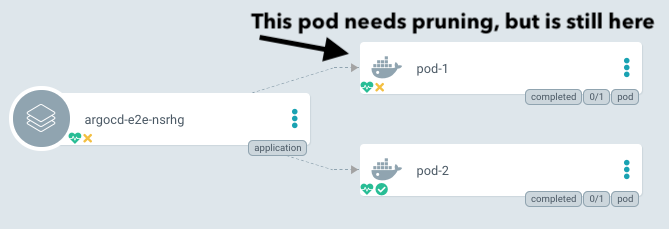Sync Options¶
No Prune Resources¶
v1.1
You may wish to prevent an object from being pruned:
metadata:
annotations:
argocd.argoproj.io/sync-options: Prune=false
In the UI, the pod will simply appear as out-of-sync:

The sync-status panel shows that pruning was skipped, and why:

The app will be out of sync if ArgoCD expects a resource to be pruned. You may wish to use this along with compare options.
Disable Kubectl Validation¶
v1.2
For a certain class of objects, it is necessary to kubectl apply them using the --validate=false flag. Examples of this are kubernetes types which uses RawExtension, such as ServiceCatalog. You can do using this annotations:
metadata:
annotations:
argocd.argoproj.io/sync-options: Validate=false
If you want to exclude a whole class of objects globally, consider setting resource.customizations in system level configuration.
Skip Dry Run for new custom resources types¶
v1.6
When syncing a custom resource which is not yet known to the cluster, there are generally two options:
1) The CRD manifest is part of the same sync. Then ArgoCD will automatically skip the dry run, the CRD will be applied and the resource can be created.
2) In some cases the CRD is not part of the sync, but it could be created in another way, e.g. by a controller in the cluster. An example is gatekeeper,
which creates CRDs in response to user defined ConstraintTemplates. ArgoCD cannot find the CRD in the sync and will fail with the error the server could not find the requested resource.
To skip the dry run for missing resource types, use the following annotation:
metadata:
annotations:
argocd.argoproj.io/sync-options: SkipDryRunOnMissingResource=true
The dry run will still be executed if the CRD is already present in the cluster.
Selective Sync¶
Currently when syncing using auto sync ArgoCD applies every object in the application. For applications containing thousands of objects this takes quite a long time and puts undue pressure on the api server. Turning on selective sync option which will sync only out-of-sync resources.
You can add this option by following ways
1) Add ApplyOutOfSyncOnly=true in manifest
Example:
syncPolicy:
syncOptions:
- ApplyOutOfSyncOnly=true
2) Set sync option via argocd cli
Example:
$ argocd app set guestbook --sync-option ApplyOutOfSyncOnly=true
Resources Prune Deletion Propagation Policy¶
By default, extraneous resources get pruned using foreground deletion policy. The propagation policy can be controlled
using PrunePropagationPolicy sync option. Supported policies are background, foreground and orphan.
More information about those policies could be found here.
syncOptions:
- PrunePropagationPolicy=foreground
Prune Last¶
This feature is to allow the ability for resource pruning to happen as a final, implicit wave of a sync operation, after the other resources have been deployed and become healthy, and after all other waves completed successfully.
syncOptions:
- PruneLast=true
This can also be configured at individual resource level.
metadata:
annotations:
argocd.argoproj.io/sync-options: PruneLast=true
Replace Resource Instead Of Applying Changes¶
By default, ArgoCD executes kubectl apply operation to apply the configuration stored in Git. In some cases
kubectl apply is not suitable. For example, resource spec might be too big and won't fit into
kubectl.kubernetes.io/last-applied-configuration annotation that is added by kubectl apply. In such cases you
might use Replace=true sync option:
syncOptions:
- Replace=true
If the Replace=true sync option is set the ArgoCD will use kubectl replace or kubectl create command to apply changes.
This can also be configured at individual resource level.
metadata:
annotations:
argocd.argoproj.io/sync-options: Replace=true
Fail the sync if a shared resource is found¶
By default, ArgoCD will apply all manifests found in the git path configured in the Application regardless if the resources
defined in the yamls are already applied by another Application. If the FailOnSharedResource sync option is set, ArgoCD will
fail the sync whenever it finds a resource in the current Application that is already applied in the cluster by another Application.
syncOptions:
- FailOnSharedResource=true
Create Namespace¶
apiVersion: argoproj.io/v1alpha1
kind: Application
metadata:
namespace: test
spec:
syncPolicy:
syncOptions:
- CreateNamespace=true
The example above shows how an Argo CD Application can be configured so it will create namespaces for the Application resources if the namespaces don't exist already. Without this either declared in the Application manifest or passed in the cli via --sync-option CreateNamespace=true, the Application will fail to sync if the resources' namespaces do not exist.